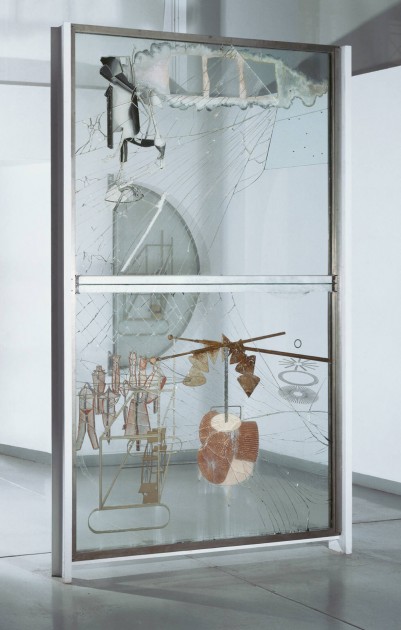Monday, March 5th, 2018
Making Damage an Advantage

Marcel Duchamp, “The Bride Stripped Bare by Her Bachelors, Even (The Large Glass),” 1915-1923. Oil, varnish, lead foil, lead wire, and dust on two glass panels, 9 feet 1 1/4 inches × 70 inches × 3 3/8 inches (277.5 × 177.8 × 8.6 cm)
Last week, some of my students and I were discussing Duchamp’s readymades. One student mentioned something to the effect of, “Well, I wouldn’t be able to just march up to a museum and hand them a broken window and expect them to accept it as a work of art.” I chuckled a bit at that comment, since Duchamp’s The Bride Stripped Bare by Her Bachelors, Even (also called The Large Glass) is made of large panes of cracked glass. The glass wasn’t broken initially, but it cracked in transit accidentally after an exhibition at the Brooklyn Museum in 1926-27.
Luckily for Duchamp, he found that the broken glass helped to complete the work of art. Previously, he had declared that the art was “definitively unfinished,” but then later determined the work of art to be complete after he pieced the glass panes back together. The cracks remind me of the delicacy of a bride’s veil. You can read more about the different forms in this object both here and here.
It is interesting to me how this accidental damage was used to help complete the work of art, and even become a feature that is celebrated as part of the aesthetic. This is different than the slashed canvases of Lucio Fontana, since those slashes were intentionally made by the artist as part of the original conception of the object.
In contrast to this accidental damage, I have blogged previously about art that is damaged intentionally, often as a result of attack. In addition, there are countless examples of works of art that have been damaged by accident, too, such as the boy who tripped in a museum in 2015, the Cairo Museum workers who accidentally knocked off King Tut’s beard (and then infarmously tried to glue it back on), and the $40 million painting by Picasso that Steve Wynn accidentally punctured with his elbow. In these instances, however, the works of art are restored to give a semblance of their original appearance; the damage isn’t celebrated from an aesthetic standpoint.
Duchamp’s cracked The Bride Stripped Bare by Her Bachelors, Even reminds me of “biography” of a work of art – the concept that objects have lives of their own. The broken glass is a reminder of the fateful trip that the object took after the exhibition at the Brooklyn Museum – and it was the only time this work of art was displayed in a temporary exhibition! Interestingly, though, the Philadelphia Museum of Art, which permanently houses The Bride Stripped Bare by Her Bachelors, Even, is interested in keeping the work of art in a more timeless and historicized space. The museum website proudly declares that the object is exhibited in the same space that Duchamp chose for it over half a century ago, when The Bride Stripped Bare by Her Bachelors, Even was acquired by the museum in 1953. In a way, perhaps this static display counteracts the sense of a living “biography” that is suggested by the object itself.
Do you know of other works of art that were accidentally damaged, and then this damage was incorporated into the finished work of art? Of course, I’m thinking of situations that are more extreme than the “happy little accidents” that Bob Ross talks about in his painting show. If you know of anything, please share!
Accident and chance is a huge aspect of surrealism and I think that’s why Duchamp was so chill about the glass breaking. Aside from just being a super chill dude, of course 🙂
Hi Heidenkind! That’s a great point about Surrealism and its stress on accident and chance. These glass panes cracked in the latter part of the 1920s, and then Duchamp glued them back together ten years later. So Surrealism was a very established movement by the time Duchamp finished repairing the broken glass.